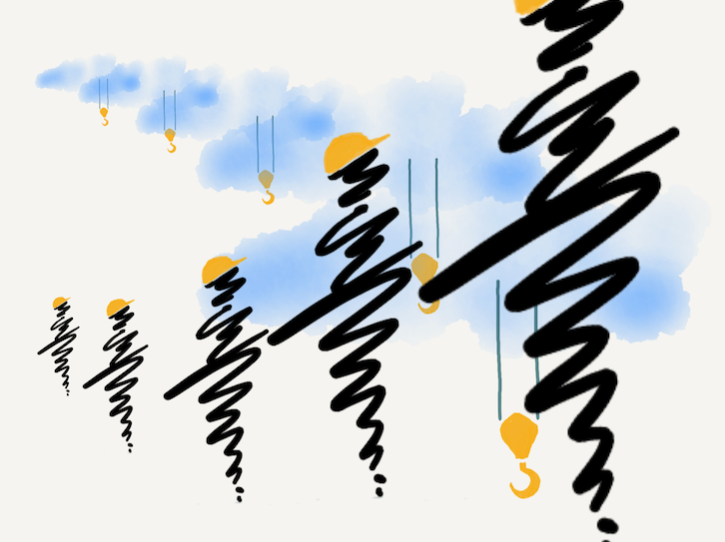My journey into Construction Engineering: Part 1 of 3
A few personal definitions
Rather like snow, my career has drifted.
A student asked why, after thirty years designing finished buildings, I have spent much of the last decade instead getting excited about the way they are built. I soon realised that answering this became complicated - partly because we all have our own definitions for the key terms.
I joined a contractor nine years ago and discovered what I suspected - that my understanding was quite patchy, and there was plenty more I needed to absorb. Being someone who enjoys ‘lifelong learning’ I seem to have spent most of the last ten years blissfully swimming out of my depth, trusting my intuition and the skills of those around me.
So, what is this ‘Construction Engineering’ thing that has entranced me? To explain that, let me first give my own definition of ‘Temporary Works Engineering’ – one perhaps influenced by my previous view from ‘Permanent Works World’.
Temporary Works
Defining Temporary Works seems easy. It’s all the things you can see on site that aren’t the building! Scaffold, props, formwork, falsework, needling, tower crane bases, sheet piling….. the list goes on. You discover that the first design crisis when a contractor wins a new project is nearly always the hoarding, because securing the site is the first job, and it needs to happen now!
If you study MMC (Modern Methods of Construction) you can see that Temporary Works solutions have been ‘on message’ for years. You are immersed in families of modular solutions, starting with the humble scaffold tube but embracing HAKI stairs, Heras fencing, RMD props……. again, the list goes on! A cost-effective solution often minimises the amount of each product you have on hire at any one time, allowing the site team to rotate this equipment through the building as the work front moves. This material reuse can make these inherently carbon efficient solutions as well!
At its simplest ‘Temporary Works’ design is almost a transactional activity. The site team phones up: “I need a hoarding”. “I need some props”. And you give them what they need, in the most cost-efficient way you can, but each activity doesn’t really have wider ramifications. Where vertical columns and simple framing allow demolition to start at the roof and head downwards, or construction to head straight upwards these transactions can be enough.
Construction Engineering
But this simplicity is rare in dense urban environments. McGee’s focus on projects in London means there are always complex logistical constraints from surrounding neighbours, historic structures and infrastructure. Previous and future building forms are convoluted as architects try to maximise benefit on high value sites. Addressing the complexities of constructing sophisticated buildings on difficult sites is where ‘Construction Engineering’ can be a useful description.
I joke that we should have “It’s always the ******* sequence” written in big letters up on the office wall. In my previous 'Permanent Works' existence I used to believe I understood the construction sequence when I had defined five or six stages on the way to completion. I have learned differently. Ten is a minimum and there are often many more than that.
It can feel like a pedantic exercise to thrash through a sequence in such great detail with the project-wide team, but so often there is that one step that turns out to be impossible, an unseen condition that needs a design check, another bit of efficiency that can be gained in construction, or just a better way of building that is waiting to be found. Once the sequence is truly understood and agreed by everyone, first the design and then construction can move ahead with risk and change minimised. The pleasure of finding, designing, and detailing the right construction sequence is one of the key things that has got me hooked to life as a designer in a contractor.
The other thing that should perhaps be written on our wall is “the best temporary works are the permanent works”. This is where my past and present regularly blur and merge. Properly understanding the needs and capacities of the structure you are working with and finding ways to maximise its temporary role is key to simplifying construction, speeding up programs and driving down cost and carbon.
Some of the most satisfying projects are where the permanent form is impossible to talk about without knowing it is constructed. Deep basements have always been supreme examples of this, and anyone who watched the recent BBC documentary “The Mayfair Hotel Megabuild” will have seen McGee’s construction team working hand in glove with Arup’s permanent works design. Projects consist of a one or two 'Construction Engineering' big moves, and a host of other 'Temporary Works' activities, all needing to be coordinated into a coherent whole.
A climate imperative
The climate crisis means that this blurring of permanent and temporary is now spreading into the reuse of superstructures. The RetroFirst movement is requiring complex surgery to remake buildings whilst retaining much of their embodied carbon on site. McGee’s solution for dividing and re-joining a nine-storey building at the Acre won the 2022 BCI Award for Temporary Works innovation with a low carbon solution that we could not have conceived and delivered without an understanding of permanent works design and whole-building analysis.
The buildings we construct are evolving rapidly, and there is an ever-greater need to skill and innovation in the way we construct them and the way we plan, design, and deliver the work on- and off- site. Traditional ‘transactional’ Temporary Works will still have a huge part to play, but the opportunities for efficiencies through more radical Construction Engineering will carry on growing.
So now that I have defined some terms, in part 2 of this blog I can start to answer that student's question and talk about some of my own reasons for enjoying leaving permanent works design behind and journeying into ‘contractor world’. My first three headlines are "Clarity, connection and diversity".





